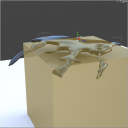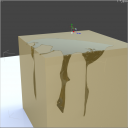dForce Slime and Goo props losing depth
Got this one recently: https://www.daz3d.com/dforce-slime-and-goo
Tried messing about with it a bit but all my results end up looking like a flat sheet is laid over the object after simulating it. The thickness of the original prop is entirely lost. See pictures below.
The slime just ends up being a very flat mess (even the corners are completely jagged and the cube is glitching trough).
Am I doing something wrong? Most of these props also do not have D-force simulation enabled by default, which I find curious since the included tutorial just says to start simulation after positioning the prop.
Anyone has the product and any clue what's going wrong?


slime3d.png
1842 x 1845 - 3M


slimenot3d.png
1842 x 1845 - 2M


Comments
Okay, got this a while ago, but haven't played with it yet, so this is as good a time as any. Maybe others can expand on this.
In the General Parameters section, you will see that the Simulation Object Type is set to Dynamic Surface, so, yes, it is dForce-ready. A cube primitive isn't set to anything, so just to make sure, Edit -> Object -> Geometry -> Add dForce Surface Modifier: Static Surface. Also, the number of subdivisions could influence the simulation depending on which collision mode you use. Sharp edges are not friendly, and I get numerous sharp un-goo-like bulges along those edges as a result. A very narrow band of the mesh is being bent at a sharp angle, so it is probably not going to be smooth. Subdividing the goo mesh smooths out those sharp edges.
You would need to use Best collision mode, bump up the subframes, iterations (per subframe), collision iterations (per subframe) and probably simulation and stabilization time. Something with a more rounded or beveled edge would probably be easier to work with.
There is still some thickness after simulating, but it is nowhere near what it started with. You could tweak some of the simulation parameters in the surface tab, but I'm sure they have been well tuned. There is also a "Fatten" morph that you can use to make the goo physically thicker after simulation. You can do it before, too, but you would lose most of the effect during simulation. Note that the Fatten morph works only in the object's Y-axis direction, so if parts of it are hanging over the edge, it will only "fatten" upwards, not out from the surface. You would need to rotate the goo object relative to the surfaces it will touch (or rotate the surface under it for the purpose of simulation and rotate it back to its original position) so that there is a Y-component to "fatten" after it settles.
Ok, seems only a few of the puddles start as static surfaces. The rest does have them set up correctly by default.
I've tried to mess around some more with it. And did indeed get some better results with fattening it. See the pictures below.
It's a real shame the tutorial included doesn't mention this. I suppose I should just really mess about with the gravity to get the appropriate droopiness for the situation..
Thanks for the tips! I'll see if it works out.